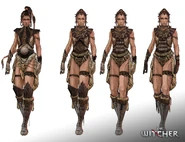No edit summary Tag: Source edit |
m (ref fixing) Tag: Source edit |
||
| Line 21: | Line 21: | ||
The continuous shrinking of the number of dragons visiting the realm led [[Saulrenith]], a priestess from one of the northern Zerrikanian cities, to propose an expedition to the Northern Realms in order to search for remaining dragons as well as spread their faith. Six priestesses and six warrioresses spent four years roaming the [[Continent]] until they were massacred by a [[dwarf|dwarven]] band hunting for a [[green dragon]]. The mission's failure prompted Queen [[Merineaevelth]] to found the ''[[Faithel]]'': a warrior order tasked with finding and protecting the holy creatures.<ref name="wgw" /> |
The continuous shrinking of the number of dragons visiting the realm led [[Saulrenith]], a priestess from one of the northern Zerrikanian cities, to propose an expedition to the Northern Realms in order to search for remaining dragons as well as spread their faith. Six priestesses and six warrioresses spent four years roaming the [[Continent]] until they were massacred by a [[dwarf|dwarven]] band hunting for a [[green dragon]]. The mission's failure prompted Queen [[Merineaevelth]] to found the ''[[Faithel]]'': a warrior order tasked with finding and protecting the holy creatures.<ref name="wgw" /> |
||
| − | The failed expedition and establishment of Faithel increased the interest in an outside world by what was once an isolationist country.<ref name="wgw" /> Holy warriors were followed by traders, alchemists and inventors, introducing previously unknown goods in [[Nordling]] and Nilfgaardian lands. Women unaffiliated with any clan, known as Free Warriors, became a common sight in foreign mercenary bands,<ref name="twotw" /> eventually leading to the situation when any Zerrikanian warrior woman abroad was mistaken to be a Free Warrior.<ref name="sod" |
+ | The failed expedition and establishment of Faithel increased the interest in an outside world by what was once an isolationist country.<ref name="wgw" /> Holy warriors were followed by traders, alchemists and inventors, introducing previously unknown goods in [[Nordling]] and Nilfgaardian lands. Women unaffiliated with any clan, known as Free Warriors, became a common sight in foreign mercenary bands,<ref name="twotw" /> eventually leading to the situation when any Zerrikanian warrior woman abroad was mistaken to be a Free Warrior.<ref name="sod">{{SoD}}</ref> |
By the second half of the 13th century, trade routes were established and western travelers began to roam Zerrikanian lands, returning with many vague or exaggerated tales.<ref name="toc" /><ref name="bof" /><ref name="caf" /><ref name="twrpg">{{TWRPG}}</ref> |
By the second half of the 13th century, trade routes were established and western travelers began to roam Zerrikanian lands, returning with many vague or exaggerated tales.<ref name="toc" /><ref name="bof" /><ref name="caf" /><ref name="twrpg">{{TWRPG}}</ref> |
||
| Line 46: | Line 46: | ||
Zerrikanian society is comprised of a number of ethnicities and races. While [[human]]s seem to be prevalent,<ref group=N>It should be noted that we know virtually nothing about cultural minorities in Zerrikania, both human and nonhuman. Sources describe either the mainstream Zerrikanian culture or just mention Zerrikania in passing; there is no official source on cultural and racial minorities.</ref> the [[Zerrikanian dialect|national language]] is at least partially derived from [[Elder Speech]]<ref name="bof" /> and existence of dwarves and other [[nonhuman]]s is not unheard of.<ref name="wgw" /> |
Zerrikanian society is comprised of a number of ethnicities and races. While [[human]]s seem to be prevalent,<ref group=N>It should be noted that we know virtually nothing about cultural minorities in Zerrikania, both human and nonhuman. Sources describe either the mainstream Zerrikanian culture or just mention Zerrikania in passing; there is no official source on cultural and racial minorities.</ref> the [[Zerrikanian dialect|national language]] is at least partially derived from [[Elder Speech]]<ref name="bof" /> and existence of dwarves and other [[nonhuman]]s is not unheard of.<ref name="wgw" /> |
||
| − | People are powerfully built, well adapted to harsh environment. Their skin tone ranges from swarthy<ref name="tw2" |
+ | People are powerfully built, well adapted to harsh environment. Their skin tone ranges from swarthy<ref name="tw2">{{Tw2}}</ref><ref name="hexer">{{Hexer}}</ref> to black,<ref name="tw1" /><ref name="netflix">{{Witcher TV}}</ref> and their hair from fair<ref name="sod" /> to dark.<ref name="netflix" /> A common practice involves tattoing bodies;<ref name="sod" /> each tattoo follows a code, denoting a specific meaning.<ref name="wgw" /> |
=== Structure of the society === |
=== Structure of the society === |
||
| Line 75: | Line 75: | ||
[[Magic]] in Zerrikania is practiced mostly by [[priest]]esses. Becoming one takes eight years, during which adepts learn the arcana of dragon magic, reading and writing [[Elder Runes]], decipher legends and mysteries written in ancient chronicles, and become accustomed with herbalism and alchemy.<ref name="wgw" /> |
[[Magic]] in Zerrikania is practiced mostly by [[priest]]esses. Becoming one takes eight years, during which adepts learn the arcana of dragon magic, reading and writing [[Elder Runes]], decipher legends and mysteries written in ancient chronicles, and become accustomed with herbalism and alchemy.<ref name="wgw" /> |
||
| − | Alchemy is one of arts practiced by both women and men. Along with various other recipies, Zerrikanian wizards and sect members became known as specialists in the usage of explosives. Used to create [[Bomb (disambiguation)|bombs]] or [[Siege weapon|siege engines]], substances developed by Zerrikanian masters were eventually brought to Nilfgaard and Northern Realms during 12th or 13th century.<ref name="tw1" /><ref name="tw2" /><ref name="twrpg" /><ref name="gwent" /> |
+ | Alchemy is one of arts practiced by both women and men. Along with various other recipies, Zerrikanian wizards and sect members became known as specialists in the usage of explosives. Used to create [[Bomb (disambiguation)|bombs]] or [[Siege weapon|siege engines]], substances developed by Zerrikanian masters were eventually brought to Nilfgaard and Northern Realms during 12th or 13th century.<ref name="tw1" /><ref name="tw2" /><ref name="twrpg" /><ref name="gwent">{{Gwent standalone}}</ref> |
Zerrikanian knowledge and [[ingredients]] find its uses in [[medic]]ine as well. One of the characteristic elements of local practices is [[Wikipedia:Acupuncture|acupuncture therapy]].<ref name="tw3" /> |
Zerrikanian knowledge and [[ingredients]] find its uses in [[medic]]ine as well. One of the characteristic elements of local practices is [[Wikipedia:Acupuncture|acupuncture therapy]].<ref name="tw3" /> |
||
| Line 87: | Line 87: | ||
Yet another example of Zerrikanian amazons are the Free Warriors: swearing alegiance neither to the clan or the queen, they are often found in mercenary groups of the Continent.<ref name="twotw" /> Their renown is high; Nordlings seeing ''Faithel'' often assume they deal with Free Warriors.<ref name="sod" /> |
Yet another example of Zerrikanian amazons are the Free Warriors: swearing alegiance neither to the clan or the queen, they are often found in mercenary groups of the Continent.<ref name="twotw" /> Their renown is high; Nordlings seeing ''Faithel'' often assume they deal with Free Warriors.<ref name="sod" /> |
||
| − | Zerrikanians are known for their production of [[zefhar]]s enforced with antelope horns<ref name="bof" /> and [[saberra]]s, a type of saber native to Zerrikania.<ref name="ttots" |
+ | Zerrikanians are known for their production of [[zefhar]]s enforced with antelope horns<ref name="bof" /> and [[saberra]]s, a type of saber native to Zerrikania.<ref name="ttots">{{TTotS}}</ref> The most destructive, however, are [[Zerrikanian fire scorpion|fire scorpions]]: siege engines shooting green fire, a couple of such combined being capable of razing entire cities. Some even say it's these machines that caused the desertification of Zerrikania ages ago.<ref name="tw3" /> |
== Economy and trade == |
== Economy and trade == |
||
| Line 95: | Line 95: | ||
Most of the Continent knows Zerrikania only through the products imported from there; it is hard to determine however which ones are produced in Zerrikania, and which ones are merely sold by Zerrikanian traders after being bought in even farther lands. Some of the wares commonly associated with Zerrikania are spices<ref name="tw3" /> and silk.<ref name="twrpg" /><ref name="tales">{{TftwoTW}}</ref> They arrive in Northern Realms either via land route through [[Elskerdeg Pass]] and [[Aedirn]],<ref name="tlotl" /><ref name="tb" /> or by sea, presumably from ports in Nilfgaardian Empire or in the lands south of the Korath.<ref name="bof" /> |
Most of the Continent knows Zerrikania only through the products imported from there; it is hard to determine however which ones are produced in Zerrikania, and which ones are merely sold by Zerrikanian traders after being bought in even farther lands. Some of the wares commonly associated with Zerrikania are spices<ref name="tw3" /> and silk.<ref name="twrpg" /><ref name="tales">{{TftwoTW}}</ref> They arrive in Northern Realms either via land route through [[Elskerdeg Pass]] and [[Aedirn]],<ref name="tlotl" /><ref name="tb" /> or by sea, presumably from ports in Nilfgaardian Empire or in the lands south of the Korath.<ref name="bof" /> |
||
| − | One of the biggest importers from Zerrikania is the [[Nordling]]-owned [[Zerrikanian Spice Company]], headquartered in [[Novigrad]] where ships with Zerrikanian products often dock.<ref name="tw3" /> Some northern organizations even have branches in Zerrikania itself, with [[Cianfanelli Bank|Bank]] of [[Cianfanelli family]] being one of the most prestigious.<ref name=" |
+ | One of the biggest importers from Zerrikania is the [[Nordling]]-owned [[Zerrikanian Spice Company]], headquartered in [[Novigrad]] where ships with Zerrikanian products often dock.<ref name="tw3" /> Some northern organizations even have branches in Zerrikania itself, with [[Cianfanelli Bank|Bank]] of [[Cianfanelli family]] being one of the most prestigious.<ref name="baw" /> |
==Notable Zerrikanians== |
==Notable Zerrikanians== |
||
Revision as of 17:50, 31 December 2020
| I saw temples dedicated to the worship of dragons. I heard their voice, almost human, but reverberating with a thousand echoes. I met warrior maids clad in leopard skins, tattooed from head to foot and giving no ground to witchers in mastery of the blade. I saw mages who channeled power from fire. I saw seemingly harmless flies whose solitary bite would make a man fall into a deep slumber, never to awake save to die. In short, Zerrikania is a land where the fantastic is normal, and the impossible occurs daily... | |||
| - The Wonders of Zerrikania | |||
Zerrikania is a vast human realm located to the east of both the Northern Kingdoms and the Nilfgaardian Empire.[N 1] Isolated from the westerners by mountain ranges, deserts and wastelands, it is often perceived as a mysterious land of warrior women, dragon cults and exotic beasts.
History
Early history
Roots of the modern Zerrikanian realm are found within a great fertile canyon surrounded by steppes and harsh barren plateaus. People of this lush region believed they had been designated by Zerrikanterment, a colossal golden dragon, as his chosen people destined to guard and take care of dragons visiting the chasm.[1]
While the canyon population is perceived as the mythological birthplace of the culture, the bulk of the Zerrikanian nation was formed by numerous steppe clans. Led by matriarchs, these warlike amazons dominated the areas around,[6][7] eventually imposing the matriarchal system within the chasm itself and establishing a monarchy. The traditional protection of dragons turned into worship,[1] with monumental temples hosting these majestic beasts being erected across the realm.[2][8]
Contact with outside world
The continuous shrinking of the number of dragons visiting the realm led Saulrenith, a priestess from one of the northern Zerrikanian cities, to propose an expedition to the Northern Realms in order to search for remaining dragons as well as spread their faith. Six priestesses and six warrioresses spent four years roaming the Continent until they were massacred by a dwarven band hunting for a green dragon. The mission's failure prompted Queen Merineaevelth to found the Faithel: a warrior order tasked with finding and protecting the holy creatures.[1]
The failed expedition and establishment of Faithel increased the interest in an outside world by what was once an isolationist country.[1] Holy warriors were followed by traders, alchemists and inventors, introducing previously unknown goods in Nordling and Nilfgaardian lands. Women unaffiliated with any clan, known as Free Warriors, became a common sight in foreign mercenary bands,[7] eventually leading to the situation when any Zerrikanian warrior woman abroad was mistaken to be a Free Warrior.[9]
By the second half of the 13th century, trade routes were established and western travelers began to roam Zerrikanian lands, returning with many vague or exaggerated tales.[4][6][8][10]
Dissidents and mercenaries
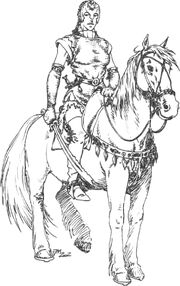
Steppe guardian
In the second half of the 13th century, the ruling Queen of Zerriania was a sorceress of bad renown, even outside her realm. She was forced to rely on foreign mercenaries in chasing dissidents dangerous to her rule. One of them, Borch Three Jackdaws, was in fact a golden dragon himself in secret.[11]
Zerrikania did not partake in the Northern Wars thus making it a destination of refugees, including Sigismund Dijkstra, Isengrim Faoiltiarna, and Boreas Mun.[12] However, the realm suffered its own civil wars, fought over the humid, forested regions.[13] Several mercenary bands looking for a job after the Battle of Brenna,[8][13] including Clan Tuirseach warriors[2] and the famed Kovirian Free Company led by Julia Abatemarco, took part in the conflict. The side supported by mercenaries took heavy loses as the foreigners, unprepared for local dangers, suffered from diseases and predatory fauna. Their native opponents took advantage from familiarity with jungle landscape and succesively won skirmish after skirmish without the mercenaries being able to even locate the enemy. After eight months of war, the foreigners were forced to retreat.[13] The Nordlings who returned home were voluntarily accompanied by Zerrikanian exiles.[8]
Geography and climate
Zerrikania is situated between the Fiery Mountains to the north and Great Korath Desert in the south.[13] It can be reached from the Elskerdeg Pass through the famed Wastelands.[12]
Descending from the mountains, one would first enter the thick, primeval forest, only to eventually cross it and reach dry steppes, deserts and barren plateaus of the Continent's interior. One such plateau is "broken" by a huge canyon up to 3 km deep. The canyon is basically a gigantic oasis hosting a unique microclimate due to its shadow's cooling effect and multiple sources of freshwater, often in form of waterfalls. All of this makes the growth of rainforest possible and provides habitats for several exotic creatures as well as human settlements. The distance from one end of the gorge to the other is 5 days of journey.[1]
Fauna and flora
Zerrikania has two distinct forest systems, one adjacent to the mountains and another down in the canyon. The canyon's rainforests comprise of several plants, some of which are almost impossible to find outside apart from Brokilon Forest. One can encounter exotic trees with large juicy fruits and flowered climber vines as well as plants that are poisonous or otherwise dangerous. Outside the forests, the vegetation is sparse.[1]
The realm hosts a number of unique animals in its varied areas, including tigers,[4] antelopes,[6] ostriches, jackals, snakes,[1] camels, and leopards.[14] Monsters that may be encountered include venomous basilisks[4] and spiders so large so they can trap elephants in their webs. One should also be vary of tse tse flies which lay eggs within human bodies.[13]
Society
Demographics
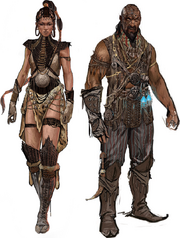
Two Zerrikanians of different backgrounds.
Zerrikanian society is comprised of a number of ethnicities and races. While humans seem to be prevalent,[N 2] the national language is at least partially derived from Elder Speech[6] and existence of dwarves and other nonhumans is not unheard of.[1]
People are powerfully built, well adapted to harsh environment. Their skin tone ranges from swarthy[15][16] to black,[13][17] and their hair from fair[9] to dark.[17] A common practice involves tattoing bodies;[9] each tattoo follows a code, denoting a specific meaning.[1]
Structure of the society
While not codified by law, the Zerrikanian society is de facto matriarchal in nature. By tradition, it's women who hold positions of power – they are clan leaders, priestesses, warriors, and teachers.
Zerrikania is ruled by a Queen, sometimes also translated as Supreme Leader. By default, the position belongs to the inheriting female clan member of the previous Queen. In instances when the successor refuses assuming the position, or when it is hard to determine who should succeed, the new Leader is chosen through popular vote held during People's Assembly: a thing-like folkmoot where each free Zerrikanian woman can submit a candidacy and cast a vote. The person elected starts a new royal line and her descendants inherit the throne once she dies.
Zerrikanian men mostly comprise a caste known as Worenkenni. The Worenkenni do communal and domestic work, such as land cultivation, mining, woodwork, and fishing. It's men who are tasked with raising children: girls up to 4 and boys up to 10. Worenkenni are also teachers of culturally masculine jobs, and sometimes become respected sages.[1]
Culture
Language and writing system
The sole official language is Zerrikanian, a heavily distorted dialect of Elder Speech. It's the only one known by all Zerrikania's inhabitants; only priestesses and Faithel learn Common or Nilfgaardian.
The written form of Zerrikanian is runic.[1]
Education
As a free Zerrikanian child reaches 4, she or he usually becomes helping parent of suitable gender in their work. As they reach 10, children become baptised in the name of Zerrikanterment; from now on, they turn from passive observers into active participants of Zerrikanian social life. They choose the job they would like to take care of and learn it for at least five years; each year, they can change the area of studies, but as they reach 15 they are obliged to decide for good. Girls between 10 to 15 are called Cule and boys Laireani; as they reach 15, they become Cule mailteini and Laireani mailten respectively, and begin practices in their chosen way of life until they are ready.
Those, who choose the life of warrior or of priestess, have to train longer to become full-fledged members of the profession.[1]
Religion
The only religion recognized by state is cult of Divine Dragons. It comprises of a "pantheon" of various ancient wyrms as well as veneration of real, living specimens hosted in temples.[1][8] Foreigners often speak about the sacrifices performed before the images of these scaled overlords.[9]
The position of the state-mandated form of worship is contested by growing cult of Lilit-Niya, a syncretic religion mixing ancient Wozgor beliefs with eastern spirituality. Its matriarchal character swayed many women across the country and the elites, making Zerrikania a true center of the religion.[18]
Magic, alchemy and medicine
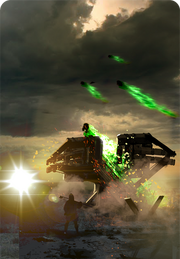
A fire scorpion shooting projectiles of Zerrikanian Fire
Magic in Zerrikania is practiced mostly by priestesses. Becoming one takes eight years, during which adepts learn the arcana of dragon magic, reading and writing Elder Runes, decipher legends and mysteries written in ancient chronicles, and become accustomed with herbalism and alchemy.[1]
Alchemy is one of arts practiced by both women and men. Along with various other recipies, Zerrikanian wizards and sect members became known as specialists in the usage of explosives. Used to create bombs or siege engines, substances developed by Zerrikanian masters were eventually brought to Nilfgaard and Northern Realms during 12th or 13th century.[13][15][10][19]
Zerrikanian knowledge and ingredients find its uses in medicine as well. One of the characteristic elements of local practices is acupuncture therapy.[2]
Warfare and weapon smithery
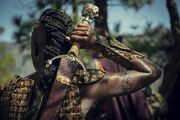
A Zerrikanian Faithel with her sword
Like other steppe nations, Zerrikanians specialize in mounted archery and sabremanship. Their legendary marksmanship skills are the topic of legends and superstitions across the Continent; a common myth amongst those uneducated with bowmanship claims that Zerrikanian amazons cut a single breast in order for it not to interfere with their aim.[6][N 3]
While the renowned Faithel order is the most characteristic, most Zerrikanian armed women belong to steppe guardians – clans' retinues protecting borders. These warrioresses train in extremal conditions, learn camouflage and aquire knowledge about plants and animals. They wear two lines of the tattoo and the "chameleon" symbol: two vortexes conjoined in "8" shape tattoed below ears.[1]
Yet another example of Zerrikanian amazons are the Free Warriors: swearing alegiance neither to the clan or the queen, they are often found in mercenary groups of the Continent.[7] Their renown is high; Nordlings seeing Faithel often assume they deal with Free Warriors.[9]
Zerrikanians are known for their production of zefhars enforced with antelope horns[6] and saberras, a type of saber native to Zerrikania.[20] The most destructive, however, are fire scorpions: siege engines shooting green fire, a couple of such combined being capable of razing entire cities. Some even say it's these machines that caused the desertification of Zerrikania ages ago.[2]
Economy and trade
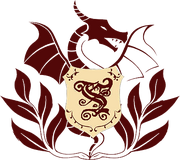
Logo of Zerrikanian Spice Company
In the steppe and the desert, most Zerrikanians are herders, living of the milk and meat their animals produce. In areas with more favourable climate the more sedentary lifestyle is possible, allowing a portion of the population to produce goods other than basic food.[1]
Most of the Continent knows Zerrikania only through the products imported from there; it is hard to determine however which ones are produced in Zerrikania, and which ones are merely sold by Zerrikanian traders after being bought in even farther lands. Some of the wares commonly associated with Zerrikania are spices[2] and silk.[10][21] They arrive in Northern Realms either via land route through Elskerdeg Pass and Aedirn,[12][11] or by sea, presumably from ports in Nilfgaardian Empire or in the lands south of the Korath.[6]
One of the biggest importers from Zerrikania is the Nordling-owned Zerrikanian Spice Company, headquartered in Novigrad where ships with Zerrikanian products often dock.[2] Some northern organizations even have branches in Zerrikania itself, with Bank of Cianfanelli family being one of the most prestigious.[14]
Notable Zerrikanians
The Witcher
Zerrikania is not visited in the game, but it is acknowledged as the home for the formulae of bombs, and famous for its alchemists.
- "Zerrikania, home of the venomous Basilisk, has given birth to other equally hideous creatures. Among them are spotted spiders so huge that they trap elephants in their webs and the no-less terrifying tse tse flies. The flies are especially repulsive, laying their eggs in the human body, the resulting larvae maturing within the host's head. The victim's brain serves as sustenance and when the larvae turn into adult flies, they leave the body through the eye sockets, now void of the previously devoured eyes."
Source
Trivia
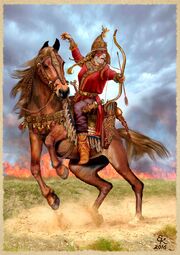
a modern reconstruction of a Scythian warrior woman
- The way Zerrikanians are described in Sapkowski's books is reminiscent of Scythians and adjacent cultures, the Iranian nomads of ancient Eurasian steppe. They were at least partially egalitarian society knowns for tattoed horse warriors; female Scythian warriors are thought to be the source of mythical Greek Amazons.
- Both CD Projekt and Netflix took other sources of inspiration in addition to Iranic Scythia. In The Witcher, while Azar Javed bears a Persian name, he is of Arabian or African ethnicity; animals mentioned in game such as tse-tse flies and elephants are characteristic to Africa, whereas the Gardener's tale about war alludes to experiences of American soldiers during Vietnam War. In Template:Witcher TV, Téa and Véa wield swords combining Congolese and Graeco-Roman features.
Notes
- If Geralt doesn't invite Letho to Kaer Morhen at the end of Ghosts of the Past, the latter says that he will flee there.
- A free DLC called Alternative look for Ciri depicts an armor from Zerrikania.[24]
Gallery
Footnotes
- ↑ While The AS Alphabet, a collection of author's notes, describes it as located in Far South, he later described it as located in the East, in The Lady of the Lake.
- ↑ It should be noted that we know virtually nothing about cultural minorities in Zerrikania, both human and nonhuman. Sources describe either the mainstream Zerrikanian culture or just mention Zerrikania in passing; there is no official source on cultural and racial minorities.
- ↑ Needless to say, the legend is false. As Milva explains in Baptism of Fire, "You pull the string to your ear and not your breast".
References
- ↑ 1.00 1.01 1.02 1.03 1.04 1.05 1.06 1.07 1.08 1.09 1.10 1.11 1.12 1.13 1.14 1.15 1.16 1.17 1.18 Wiedźmin: Gra Wyobraźni
- ↑ 2.0 2.1 2.2 2.3 2.4 2.5 2.6 2.7 The Witcher 3: Wild Hunt
- ↑ Consistent throughout books and games
- ↑ 4.0 4.1 4.2 4.3 Time of Contempt
- ↑ The Witcher: Versus
- ↑ 6.0 6.1 6.2 6.3 6.4 6.5 6.6 Baptism of Fire
- ↑ 7.0 7.1 7.2 The World of the Witcher
- ↑ 8.0 8.1 8.2 8.3 8.4 8.5 Szpony i kły
- ↑ 9.0 9.1 9.2 9.3 9.4 Sword of Destiny
- ↑ 10.0 10.1 10.2 The Witcher Role-Playing Game
- ↑ 11.0 11.1 Thronebreaker: The Witcher Tales
- ↑ 12.0 12.1 12.2 The Lady of the Lake
- ↑ 13.0 13.1 13.2 13.3 13.4 13.5 13.6 The Witcher
- ↑ 14.0 14.1 Blood and Wine expansion
- ↑ 15.0 15.1 The Witcher 2: Assassins of Kings
- ↑ The Hexer
- ↑ 17.0 17.1 Template:Witcher TV
- ↑ 2nd Edition of Wiedźmin: Gra Wyobraźni
- ↑ Template:Gwent standalone
- ↑ The Tower of the Swallow
- ↑ Tales from the world of The Witcher
- ↑ Granica możliwości
- ↑ The Witcher
- ↑ Marcin Momot:"Yes. It's Ciri's Zerrikanian outfit."
External Links
- Official article on Zerrikania written by Martyna "Sara" Tomaszewska for Wiedźmin: Gra Wyobraźni RPG (Polish)
| Countries and regions in The Witcher | |
|---|---|
| Northern Kingdoms | |
| Nilfgaardian Empire | |
| Eastern Lands |
|
| Far South | |
| Western Continent | |
| Former Regions | |

